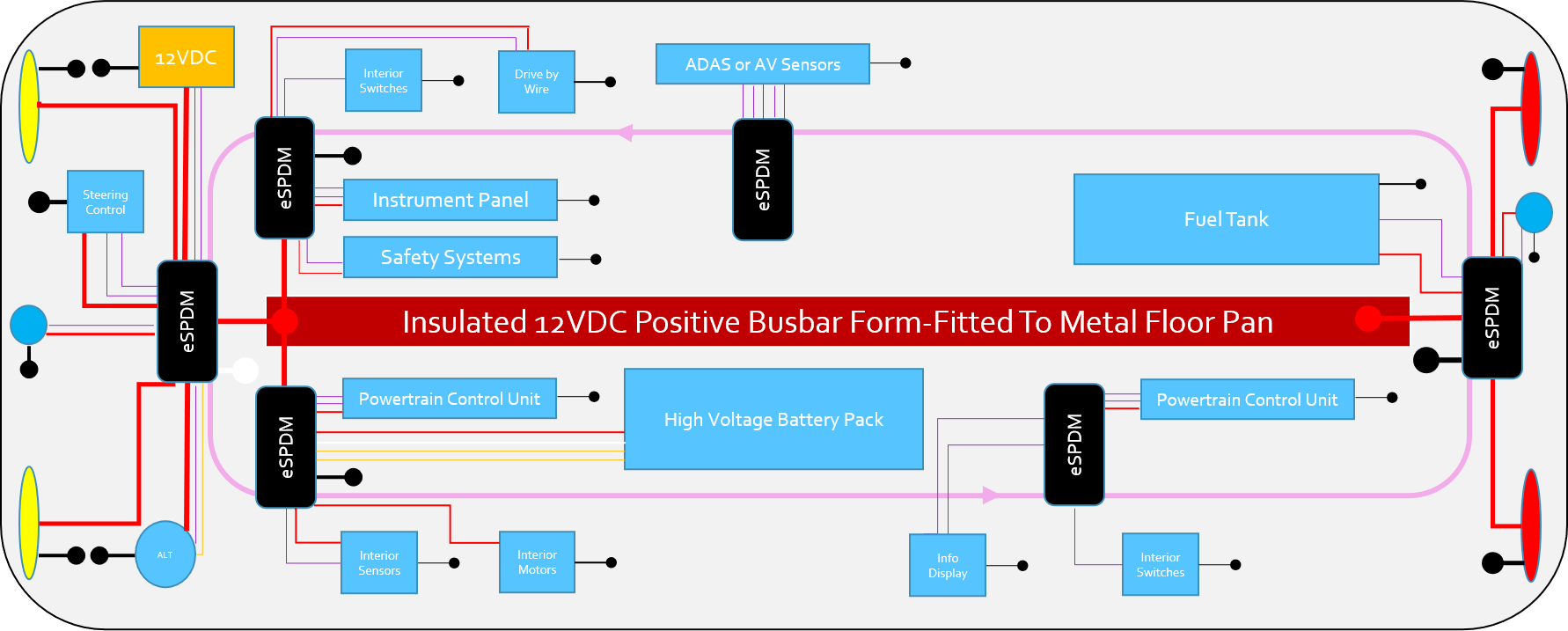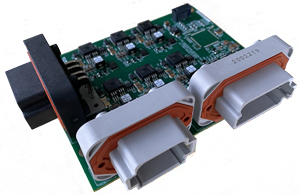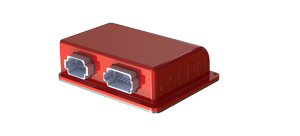New Technology for Smart Wiring Systems
It’s unlikely wiring systems will ever be totally displaced by technology.Whether it’s automotive, specialty transportation, military, or aerospace, innovation tends to enhance the critical nature of wiring systems. But because of weight and cost constraints, there is always a push towards technology to eliminate wire from vehicles and airframes.
One such technology was revealed to Wiring Harness News at The Battery Show in Novi Michigan this past September. Martin Technologies announced their new Electronic Smart Power Distribution Module (eSPDM) earlier that week. WHN had a detailed discussion with Michael Van Steenburg, Global CTO at Martin Technologies, about the company, the product development story, and how the new technology works.
Martin Technologies is deeply involved in the engineering, development and manufacturing of components for vehicle electrification in the automotive, aerospace, defense and marine sectors. “Our founder, Harold Martin, began as a GM engineer and helped develop the Cadillac Northstar 32-valve engine along with about 20 other engines from a clean sheet of paper, and has 10 world patents to his credit,” Michael revealed. Coming from a successful history in drag racing, they most recently were chosen to build all the harnesses for the Dodge Challenger Mopar Drag Pak.
The company has developed wire harnesses for years in the transportation field, working with other companies like Amphenol in both low and high voltage programs. With all of their varied accomplishments, Martin Technologies was awarded a grant to work with an Israeli defense company to develop an electronic smart power distribution module. The first iteration was proven in various military applications. It’s already operating in Israeli military aircraft and armored land vehicles.
The eSPDM is a smart wiring system technology consisting of electronic power distribution modules (Fig. 1). It has six channels with up to 13 amps per channel. “You can think of it as kind of a neural network instead of a wire harness,” Michael described. Onboard programing performs the function of switches, relays, actuators, circuit breakers and other legacy system controls. These modules perform all the signal and power functions of a large wire harness. They are connected by a central bus bar for power and typically use a single wire for signal transfer. “Your headlight switch no longer has to go all the way up to the headlights,” Michael said. “Now it goes to a module and then the module communicates to the other module and says, ‘hey turn the headlights on.’”

Instead of having large harnesses throughout the vehicle, you have the eSPDM modules connected by fewer, much smaller, milliamp wires. Martin Technologies also developed an encrypted communication method that can actually send signals over the power cabling (bus bar) at different frequencies and wavelengths to further reduce wiring.
The system is all solid-state and has a wide voltage range of 5V up to 60V DC. Initial applications have been mostly with low-voltage, but the eSPDM’s is also adding high-voltage power for EV systems. “We have a high voltage daughter board that plugs on top of the eSPDM to control up to 800V power distribution systems for EVs.”

Michael see’s the eSPDM as a way to integrate old and new technologies. “You’re still going to have wires; they will just be smaller. And now you can use a ribbon cable and even printed circuits instead of wrapped bundles of wire,” he instructed. This makes it much easier to route wires through the vehicle, airframe or machine apparatus. “It also gives us the opportunity to use composite body panels and use the chassis as a printed circuit board.”
The eSPDM also brings many new safety redundancies to the electrical system. Even if there is a fault in one module, or there is damage from an accident, there is a way for the other modules to pick up the slack and help control critical systems at minimally functioning levels.
There are actually two additional levels of safety/protection offered by the eSPDM. “We have software that allows us to look at overcurrent, overvoltage or overtemperature type conditions on all circuits that we are powering, both inputs and outputs,” Michael conveyed. This detection happens in less than a microsecond. “So, we can actually detect a short before the wire even heats up,” he informed.
The next level of protection is with a cascade option that is configurable with over 20 flexible parameters for each channel individually. “In addition, it also tracks data, so it measures input voltage output voltage the load current temperature and it’s all communicable over a CAN bus or LIN bus,” he detailed.
Michael described the typical architecture for automotive applications of the eSPDM in more detail. “Basically, you have a flat bus bar that is form-fitted to the floor pan of the vehicle, and that’s where it gets its positive power from. Of course, the negative return is to the vehicle chassis, but we can also run a negative bus bar if the body is fully composite.”
Once installed, the eSPDM can actually configure itself to the entire electrical system. “Basically, you can install it in a vehicle or system, and it says, ‘ok, circuit 13 is the headlight.’ It will recognize the characteristics of the component, adjust the circuits to accommodate it, and repeat that function to map out programing for all the circuits” Michael explained. “We can even gang channels together and put them in parallel to provide more amperage to power a starter, for example.”
It was no surprise we ran into Michael at the Battery Show. With many EV platforms in development, he is hoping to get the technology specified in the development stage. He is confident that as the eSPDM enters service in newly developed EVs, the legacy manufacturers will recognize the viability of the technology and embrace it. He was very excited to mention the eSPDM will be in production on the new EV Volcon ATV vehicles, and they have others lined up as well.
The exciting thing for our industry is that open-source units will be available off-the-shelf for companies. Anyone on the ground floor in development of autonomous vehicles, robotic systems, or any complex electrical system can integrate a smart wiring system to improve functionality and reduce costs for their customer. “We tend to think automotive because we are, at our core, an automotive supplier. But really, anything that switches power is an application.”
Martin Technologies sees a clear path for eSPDM, and Michael is excited about its implications for traditional harnesses and electrical wiring systems. “I think that, as an industry, we need to keep evolving with technology, and anywhere we can put advanced technology to work that increases reliability, reduces maintenance, reduces failure and adds to safety, then why not do it.”
—————































































